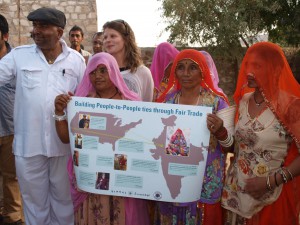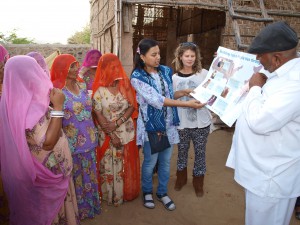In 2013, Shannon Biggs traveled with Global Exchange to India with Dr. Vandana Shiva, and got a surprise visit from His Royal Highness, Prince Charles. In preparation for our next trip to India this November, we are re-posting Shannon’s report-back here.
…

Prince Charles and Vandana Shiva, Global Exchange delegation, other visitors and Navdanya staff.
Arriving in Delhi (or nearly anywhere in India), can be a bit of a cultural hard landing for those not from the country. As my friend and Rights of Nature Reality Tour participant, Suzanne York said, “The sights — cows in the road, cars, motorcycles, bicycles, trucks, auto rickshaws, bicycle rickshaws, begging mothers, horse and cart, dogs, goats, pedestrians; I’m sure I’m leaving one or two things out. The sounds – car horns, truck horns, rickshaw horns, firecrackers, dogs barking…did I mention the horns?” Yet despite the pollution and the crowded chaos of the city streets, there is a magic and a poetry that keeps travelers like Suzanne coming back to India time and again (this marked her 5th India trek).
Over a billion people live in India. High levels of poverty and pollution met us in the cities, just as environmental degradation is visible on farms, dried riverbeds, and throughout the countryside. Yet India is equally a land of peaceful, transformative revolution and a cultural and spiritual legacy of dignity for people and sacred respect for the Earth.
Along with spending time with world renowned anti-globalization movement leader, physicist, and eco-feminist, Vandana Shiva, founder of the seed-saving and Earth learning farm, Navdanya, it is this dichotomy that we came to explore in the age of climate chaos, corporate globalization and its quest for endless growth on a finite planet. Rights of Nature, which, as put forward in the Constitutions of Ecuador, national laws in Bolivia and New Zealand, and a growing number of U.S. communities—defines legal rights for ecosystems to “exist, flourish, and regenerate their natural capacities.”
What is the promise of Rights of Nature in a place like this?
Did you know there are more NGOs in India than anywhere else?
While our Reality Tour tour visited a few big cities, the focus of the trip was on India’s growing work for Rights of Nature and how that fits with Gandhi’s legacy of peaceful revolution for change.

It is here we learn that there are more NGO’s—whether advocacy groups or direct service providers—than hospitals or schools in India. Here non-profits provide support in formal and informal settings. Many are very small, connecting people in rural settings and big cities with very localized support.
In Delhi, near the railway station, we walked the troubled street life of homeless youth with our guide, a young man who![photo[10]](https://globalexchange.org/wp-content/uploads/photo10-300x225-2.jpg) figures he’s about 22, having been discarded by his father when he was around 5. Now college-bound, he works for the famed Salaam Baalak Trust, an organization that helps homeless children find safety and alternatives to drugs (which are commonly introduced to kids as young as 5 years of age on the streets), and possibly a new future. Our group also met with scholars and activists in the movement against the Korean-based POSCO corporation’s dangerous and deadly project to build a 12 million-tons-per-year steel plant in Orissa, with a captive port and iron ore mines. According to the India Times, more than 250 international human rights organizations, comprising social workers, scientists, legal luminary activists, academics among others, have strongly criticized the Orissa government for using forces to acquire fertile lands on behalf of the corporation, a practice also know as “land grabs.”
figures he’s about 22, having been discarded by his father when he was around 5. Now college-bound, he works for the famed Salaam Baalak Trust, an organization that helps homeless children find safety and alternatives to drugs (which are commonly introduced to kids as young as 5 years of age on the streets), and possibly a new future. Our group also met with scholars and activists in the movement against the Korean-based POSCO corporation’s dangerous and deadly project to build a 12 million-tons-per-year steel plant in Orissa, with a captive port and iron ore mines. According to the India Times, more than 250 international human rights organizations, comprising social workers, scientists, legal luminary activists, academics among others, have strongly criticized the Orissa government for using forces to acquire fertile lands on behalf of the corporation, a practice also know as “land grabs.”
![photo[16]](https://globalexchange.org/wp-content/uploads/photo16-300x225-2.jpg)
In Jaipur, better known as the ‘Pink City,’ we celebrated Diwali, the Festival of Lights, and participated in an entrancing ceremony at the temple of Birla Mandir, honoring Lakshmi, Goddess of both material and spiritual prosperity, for whom Diwali is celebrated, as fireworks and firecrackers and light displays illuminated the skyline. By day we also met with a large group of women empowered through a community micro lending project. From there it was a quick 6 hours by bus to Agra, a city of stark contradictions. The streets are barely able to contain the carpeting of trash and piles of garbage bags, all in the midst of luxury hotels surrounding the Taj Majal. The haze of pollution and the sheer volume of Diwali firework smoke still hanging in the air made it hard to see the Taj from any distance, but stepping closer to this world wonder it is a palpable marvel of architecture and cultural history.
What the Earth tells us if we listen

Next stop, a working farm called Navdanya, which promotes biodiversity conservation, organic farming, seed saving, the rights of farmers and the rights of nature. The farm sits a quiet distance back from the bustle of Dehra Dun and its mere 600,000 inhabitants. As the bus pulls up to the gravel road marked with newly laid chalk, we walk the last 1/2 mile to the open gate of the learning farm. After settling in to our appropriately spartan rooms, equipped with solar showers distilling rain catchment water from the roof, we sit in the gazebo for a conversation with Vandana Shiva before taking a tour of the farm.
Navdanya’s Soil Ecology Lab and Bija Vidyapeeth (Earth University) draws inspiration from India’s first Nobel poet (1917), Tagore, who created a university based on living in and learning from the Earth. “We must stop living as owners of the Earth, because it is a fallacy that we can continue that path. Here on the farm, we can first begin to learn to be a member of the Earth community,” says Vandana. Circled around her, we speak to Vandana for an hour or more, as she explains the farm, the library, the community activities, and invites us to get our hands dirty while we are there. As the sun gets lower in the sky, she encourages us to walk the grounds, we will meet again tomorrow.
It smells good here, energizing. It feels good here, with the crunch of the Earth beneath our feet. We walk the grounds as our guide, Anna, an intern from France staying on for 6 months, explains that all the food prepared each day for upwards of 50 people, comes from the bounty grown in the humble fields before us. Despite the expertise of the staff and its transient population of interns, scientists, researchers and farmers who have come from around the world—it is the land that is the true teacher here. The rows of plantings are tidy, but not uniform. Anna explains that plants with shallow root systems are placed next to compatible plantings that take their nutrients at deeper levels of soil. Dotted around those are marigolds and other natural insecticides, and crops that replace nutrients the others remove. These acre plots are surrounded by fruit bearing trees and quick growing bamboo. There is a healthful pharmacy planted as well, providing ingredients for the soap used, and natural remedies to treat “Delhi Belly”and other ailments.
Our guide points to another series of single-acre plots, part of a project dedicated to teaching farmers how to grow organic, regionally and nutritionally rich food for a family of 6 on only one acre of land. As Vandana says, “the idea that we need corporate farming to feed a hungry planet is a destructive notion that contributes to the breakdown of the farming system. We demonstrate the viability of self-sufficient farming that relies only on the relationship between farmer and the land. No chemicals, no GMOs, no seed patenting. Here we plant in right relationship with the land.”
As the sun goes down bringing a chill to the air, it is too dark to finish the tour so we pass the barn, and say hello to the new calf and the two cows that provide milk for the chai tea we are about to enjoy back at the dining hall. That night in the lecture hall, in preparation for tomorrow’s Royal visitor, the lecture on permaculture was postponed in favor of watching the film “Harmony”, a collaboration with Vandana Shiva and outspoken advocate for organic farming, His Royal Highness, Prince Charles who first converted his Scottish home, Highgrove Castle to organic in 1986, to great public ridicule.
Rights of Nature: A gift fit for a prince
![HRH Prince Charles in conversation with our delegation photo[7]](https://globalexchange.org/wp-content/uploads/photo7-300x229-3.jpg)
By sheer coincidence, Prince Charles and his wife the Dutchess were in India on a general tour, and while Camilla was off making pottery in Debra Dun, the prince walked the farm with Vandana, the same tour we had taken with Anna, ultimately visiting the seed bank where Navdanya conserves 1,500 seed varieties. There he planted two varieties of barley, and ultimately made his way to the gazebo, where the rest of the staff and visitors were drinking chai.
Accompanied by Vandana, he spent about 15 minutes with our delegation, readily making jokes and asking questions about our journey, Green party politics in Texas, the state of the US anti-GMO movement. Introducing our group, I described the delegation’s purpose, and shared our understanding that currently, law treats nature as property, and that our legal systems are aimed at controlling and dominating nature. (So far he seemed interested, so I continued): unless we begin to use law to drive rights for communities and ecosystems, the natural and organic farms that he championed were all under threat from agribusiness, GMOs, and industrial activities like fracking. I wrapped up my sermon by giving him a copy of our Rights of Nature book, which I mentioned was written by people he knew, including Vandana Shiva, Archbishop Desmond Tutu, Bolivian President Evo Morales, and others.
Once the caravan departed and the Royal dust settled, our group sat down with Vandana Shiva for a discussion on Rights of Mother Earth, water and seed saving. “The seed, for the farmer, is not merely the source of future plant food, it is the storage place of culture, of history,” as Vandana has said. “Seed is the first link in the food chain. It is also the source of life itself, the ultimate symbol of food security.” Through patents on seeds, Monsanto has become the “Life Lord” on the planet, collecting rents from life’s renewal and from farmers, the original breeders. Patents on seed are illegitimate because putting a toxic gene into a plant cell is not the “creation” or invention of the plant.

When seeds are no longer the bounty of the Earth, but corporate property, the farmer enters the cycle of being forced to purchase Monsanto corporation’s seeds, which do not produce as promised, take more water to grow, and require expensive pesticides—putting farmers into debt they cannot repay. This is the leading cause of farmer suicides in India, and a growing phenomenon in the United States, as corporations like Monsanto gain control over farmers everywhere. “That is why we have started Fibres of Freedom in the heart of Monsanto’s Bt (GMO) cotton/suicide belt in Vidharba. We have created community seed banks with indigenous seeds and helped farmers go organic. No GMO seeds, no debt, no suicides.” Before we left Navdanya we gave a presentation to the community on Rights of Nature, speaking about communities in the United States, and the movement around the world. (Watch Shannon Biggs and Vandana Shiva speak on the Global Exchange panel at the UN Rio + 20 summit in 2012.)
Floating candles, flowers and prayers for the Rights of the Ganga
![photo[18]](https://globalexchange.org/wp-content/uploads/photo18-252x300-2.jpg)
Despite the undrinkable nature of tap water for visitors, or the toxins and pollution that flow freely into the waterways from homes and industry—water in India is sacred, and nowhere more so than the Ganges, or the Ganga, as she is called. We left the farm for Rishikesh, a hilly village that is as famous for its role in the making of the Beatles’ White Album as it is for its stunning landscape, built around the Ganga and framed by the Himalayas. It provides about 40% of India’s water, though the entire watershed is breaking down under the intense strains of use and abuse.
The widespread Save Ganga movement follows the Gandhian model for peaceful change. A powerful component of that broad coalition is the National Ganga Rights Movement, led by the charismatic Pujya Swami Chidanand Saraswatiji. We met with him and his staff, sitting cross legged on the ground in a small quiet garden oasis behind their office. “Welcome Home,” Swami greeted us. As he would explain, we breathe the same air that our ancestors did, drink the same water and are connected to one another by the web of life. So we are always home.
They are working to pass a national Ganges Rights Act to protect the entire river watershed with our allies at CELDF. Some of the language included in the Act can also be found in a chapter we wrote with Mari Margil, for our book, Rights of Nature: The Case for A Universal Declaration on the Rights of Mother Earth. It was exciting to see it being used in actual legislation:
“Under a rights-based system of law, a river may be recognized as having the right to flow, fish and other species in a river may be recognized as having the right to exist and evolve, and the flora and fauna that depend on a river may be recognized as having the right to thrive. This legal framework seeks to protect the natural ecological balance of that habitat. Just as the lion hunts the antelope as part of the natural cycle of life, recognizing Rights of Nature does not put an end to fishing or other human activities. Rather, it places them in the context of a healthy relationship where our actions do not threaten the balance of the system upon which we depend. Further, these laws do not stop all development, rather they halt only those activities that interfere with the existence and vitality of the ecosystems dependent upon that land.”
Today, the Ganga River Basin is right-less, mere property to be used at will. The proposed legislation would:
• Establish the basin’s right to exist, thrive, regenerate, and evolve;
• Establish the rights of the people, as well as other ecosystems and natural communities, to a healthy river basin;
• Provide that any activity that interferes with the basin’s rights is prohibited;
• Provide that any damages that may be awarded for violations of the basin’s rights are to be awarded for the purpose of, and in the amount necessary to, restore the ecosystem to its pre-damaged state;
• Establish enforcement mechanisms to protect and defend the basin’s rights, including establishing governmental offices responsible for defending those rights; and
• Empower people, communities, civil society, and governments within India to protect and defend the basin’s rights.
One of the ways the Ganga Rights movement is spreading education is through the Aartis, a devotional ritual that uses fire as an offering, held daily at 6 pm in the three most spiritual parts of the Ganges, including Rishikesh. Each night thousands come to the river to participate in this beautiful ceremony. The Priests say a prayer using lanterns, and the people float flowers and candles down the river in tiny boats made of woven leaves. The offering is made to the Goddess Ganga, goddess of the most holy river in India. With prayer, it is believed the holy Ganga can cleanse the sins of the devoted. “The problem is,” says Swami Saraswatiji, “people believe that in addition to washing away sins, many believe the river can clean the toxins. We use the aarti each night to educate people about the rights of the Ganga, and what is needed from us to protect her.” The swami is one of the priests who preside over the Rishikesh aarti, which Prince Charles and Camilla had attended the night before.
![Offering blessings for Ma Ganga at the Aarti at Hardiwar photo[9]](https://globalexchange.org/wp-content/uploads/photo9-300x225-2.jpg)
Our last stop on the Ganges was in Hardiwar, considered the holiest of places on the river Ganges and where we would take in an Aarti. Thousands came, prayed and left. It is not a long ceremony. As I stood with my feet in the river Ganges, I said a quiet prayer for the rights of this river, and for the people that would come together to defend those rights, and sent my flowers and my thoughts floating quietly into the night.

Shannon Biggs explaining Rights of Nature to Prince Charles, with Vandana Shiva
Click here to learn about our next trip to India, November 1-11, 2015!
…


![photo[10]](https://globalexchange.org/wp-content/uploads/photo10-300x225-1-2.jpg) figures he’s about 22, having been discarded by his father when he was around 5. Now college-bound, he works for the famed
figures he’s about 22, having been discarded by his father when he was around 5. Now college-bound, he works for the famed ![photo[16]](https://globalexchange.org/wp-content/uploads/photo16-300x225-1-2.jpg)

![HRH Prince Charles in conversation with our delegation photo[7]](https://globalexchange.org/wp-content/uploads/photo7-300x229-1-1.jpg)

![photo[18]](https://globalexchange.org/wp-content/uploads/photo18-252x300-1-2.jpg)
![photo[19]](https://globalexchange.org/wp-content/uploads/photo19-225x300-1-2.jpg)

![Offering blessings for Ma Ganga at the Aarti at Hardiwar photo[9]](https://globalexchange.org/wp-content/uploads/photo9-300x225-1-2.jpg)



![photo[10]](https://globalexchange.org/wp-content/uploads/photo10-300x225-2.jpg) figures he’s about 22, having been discarded by his father when he was around 5. Now college-bound, he works for the famed
figures he’s about 22, having been discarded by his father when he was around 5. Now college-bound, he works for the famed ![photo[16]](https://globalexchange.org/wp-content/uploads/photo16-300x225-2.jpg)

![HRH Prince Charles in conversation with our delegation photo[7]](https://globalexchange.org/wp-content/uploads/photo7-300x229-3.jpg)

![photo[18]](https://globalexchange.org/wp-content/uploads/photo18-252x300-2.jpg)
![Offering blessings for Ma Ganga at the Aarti at Hardiwar photo[9]](https://globalexchange.org/wp-content/uploads/photo9-300x225-2.jpg)





























